英语面试六种题型及教案设计
- 格式:doc
- 大小:32.50 KB
- 文档页数:9
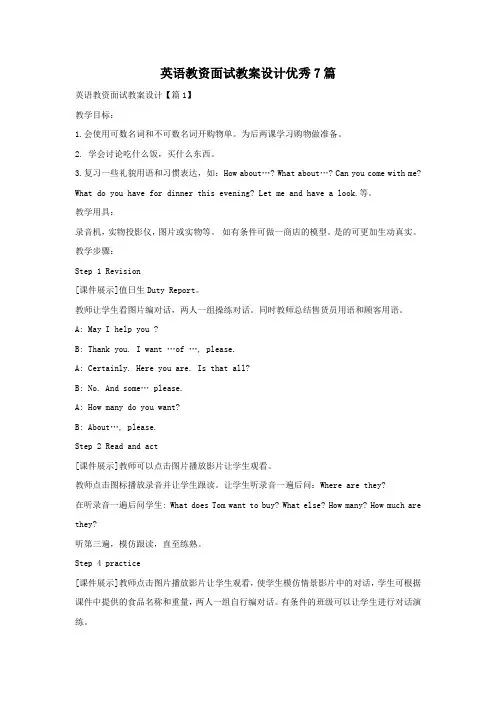
英语教资面试教案设计优秀7篇英语教资面试教案设计【篇1】教学目标:1.会使用可数名词和不可数名词开购物单。
为后两课学习购物做准备。
2. 学会讨论吃什么饭,买什么东西。
3.复习一些礼貌用语和习惯表达,如:How about…? What about…? Can you come with me? What do you have for dinner this evening? Let me and have a look.等。
教学用具:录音机,实物投影仪,图片或实物等。
如有条件可做一商店的模型。
是的可更加生动真实。
教学步骤:Step 1 Revision[课件展示]值日生Duty Report。
教师让学生看图片编对话,两人一组操练对话。
同时教师总结售货员用语和顾客用语。
A: May I help you ?B: Thank you. I want …of …, please.A: Certainly. Here you are. Is that all?B: No. And some… please.A: How many do you want?B: About…, please.Step 2 Read and act[课件展示]教师可以点击图片播放影片让学生观看。
教师点击图标播放录音并让学生跟读。
让学生听录音一遍后问:Where are they?在听录音一遍后问学生: What does Tom want to buy? What else? How many? How much are they?听第三遍,模仿跟读,直至练熟。
Step 4 practice[课件展示]教师点击图片播放影片让学生观看,使学生模仿情景影片中的对话,学生可根据课件中提供的食品名称和重量,两人一组自行编对话。
有条件的班级可以让学生进行对话演练。
Step 5 Listen and answer[课件展示]教师点击图标播放录音,同时让学生观看课件中的问题,要求学生边听边记。

教资英语面试试题及答案一、教学设计题1. 题目:如何教授初中英语中的一般现在时态?2. 要求:请设计一个教学方案,包括教学目标、教学方法、教学过程和评价方式。
答案:教学目标:- 学生能够理解一般现在时态的基本用法。
- 学生能够正确使用一般现在时态描述日常活动和习惯。
教学方法:- 利用多媒体教学,展示不同情境下的一般现在时态使用。
- 通过角色扮演和小组讨论,让学生实践时态的运用。
教学过程:1. 引入:通过播放一段视频,展示人们的日常活动,引导学生观察并讨论。
2. 讲解:教师详细解释一般现在时态的构成和用法。
3. 练习:学生完成一系列填空和转换句子的练习,巩固语法知识。
4. 应用:分组进行角色扮演,用一般现在时态描述自己的日常生活。
5. 评价:通过学生自评和互评,以及教师的反馈,评价学生的表现。
评价方式:- 观察学生在角色扮演中的语言表达能力。
- 检查学生的练习完成情况。
- 通过小测验来评估学生对一般现在时态的掌握程度。
二、案例分析题1. 题目:一位英语教师在课堂上使用游戏教学法,但发现学生对游戏不感兴趣,如何改进?2. 要求:分析原因并提出改进措施。
答案:原因分析:- 游戏可能与学生的实际生活或兴趣不符。
- 游戏规则可能过于复杂,学生难以理解。
- 游戏可能没有充分激发学生的参与热情。
改进措施:1. 了解学生的兴趣和需求,设计符合他们口味的游戏。
2. 简化游戏规则,确保学生能够快速上手。
3. 增加游戏的互动性和竞争性,提高学生的参与度。
4. 结合教学内容,确保游戏与学习目标紧密相关。
5. 定期收集学生反馈,根据反馈调整游戏内容。
三、教学反思题1. 题目:在一次英语教学中,你发现学生对某个语法点理解不透彻,你将如何进行教学反思?2. 要求:描述教学反思的过程和可能的改进方法。
答案:教学反思过程:1. 分析原因:回顾教学过程,找出学生理解不透彻的原因。
2. 收集反馈:向学生询问他们的困惑点,了解他们的学习障碍。
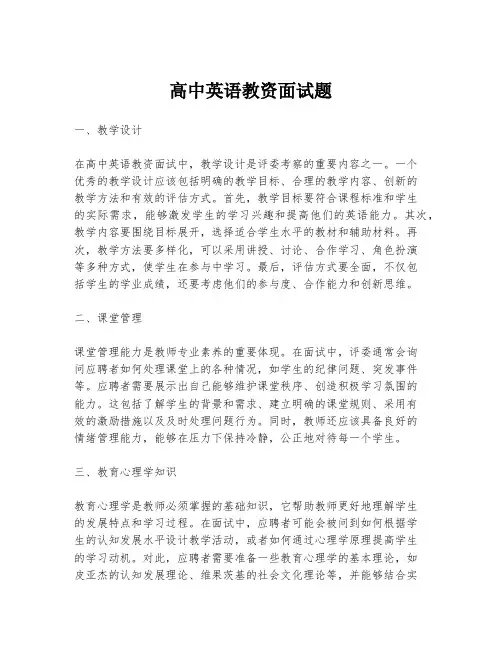
高中英语教资面试题一、教学设计在高中英语教资面试中,教学设计是评委考察的重要内容之一。
一个优秀的教学设计应该包括明确的教学目标、合理的教学内容、创新的教学方法和有效的评估方式。
首先,教学目标要符合课程标准和学生的实际需求,能够激发学生的学习兴趣和提高他们的英语能力。
其次,教学内容要围绕目标展开,选择适合学生水平的教材和辅助材料。
再次,教学方法要多样化,可以采用讲授、讨论、合作学习、角色扮演等多种方式,使学生在参与中学习。
最后,评估方式要全面,不仅包括学生的学业成绩,还要考虑他们的参与度、合作能力和创新思维。
二、课堂管理课堂管理能力是教师专业素养的重要体现。
在面试中,评委通常会询问应聘者如何处理课堂上的各种情况,如学生的纪律问题、突发事件等。
应聘者需要展示出自己能够维护课堂秩序、创造积极学习氛围的能力。
这包括了解学生的背景和需求、建立明确的课堂规则、采用有效的激励措施以及及时处理问题行为。
同时,教师还应该具备良好的情绪管理能力,能够在压力下保持冷静,公正地对待每一个学生。
三、教育心理学知识教育心理学是教师必须掌握的基础知识,它帮助教师更好地理解学生的发展特点和学习过程。
在面试中,应聘者可能会被问到如何根据学生的认知发展水平设计教学活动,或者如何通过心理学原理提高学生的学习动机。
对此,应聘者需要准备一些教育心理学的基本理论,如皮亚杰的认知发展理论、维果茨基的社会文化理论等,并能够结合实际教学情境进行应用。
四、教育技术应用随着科技的发展,教育技术在教学中的作用越来越重要。
面试中,评委可能会询问应聘者如何利用多媒体工具、网络资源和教育软件来辅助教学。
应聘者应该展示自己对现代教育技术的熟悉程度,以及如何将这些技术融入到教学设计中,提高教学效率和学生的学习体验。
同时,也需要讨论如何确保技术应用的安全性和适宜性,避免可能的负面影响。
五、教育政策和法规作为一名教师,了解并遵守教育政策和法规是基本的职业要求。
面试时,评委可能会测试应聘者对当前教育政策的理解,如新课程改革、素质教育等。
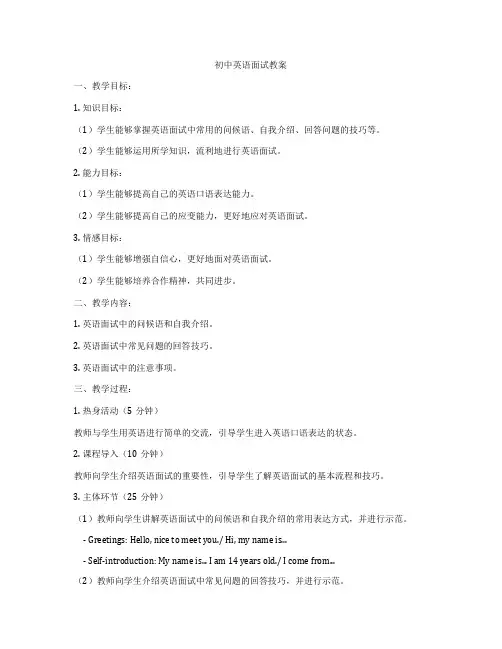
初中英语面试教案一、教学目标:1. 知识目标:(1)学生能够掌握英语面试中常用的问候语、自我介绍、回答问题的技巧等。
(2)学生能够运用所学知识,流利地进行英语面试。
2. 能力目标:(1)学生能够提高自己的英语口语表达能力。
(2)学生能够提高自己的应变能力,更好地应对英语面试。
3. 情感目标:(1)学生能够增强自信心,更好地面对英语面试。
(2)学生能够培养合作精神,共同进步。
二、教学内容:1. 英语面试中的问候语和自我介绍。
2. 英语面试中常见问题的回答技巧。
3. 英语面试中的注意事项。
三、教学过程:1. 热身活动(5分钟)教师与学生用英语进行简单的交流,引导学生进入英语口语表达的状态。
2. 课程导入(10分钟)教师向学生介绍英语面试的重要性,引导学生了解英语面试的基本流程和技巧。
3. 主体环节(25分钟)(1)教师向学生讲解英语面试中的问候语和自我介绍的常用表达方式,并进行示范。
- Greetings: Hello, nice to meet you./ Hi, my name is...- Self-introduction: My name is... I am 14 years old./ I come from...(2)教师向学生介绍英语面试中常见问题的回答技巧,并进行示范。
- Why do you want to study here?- What are your hobbies?- What is your favorite subject?(3)学生进行小组讨论,共同总结英语面试中的注意事项。
- Be punctual.- Dress properly.- Listen carefully.4. 实践环节(15分钟)学生分成小组,进行角色扮演,模拟英语面试的场景。
教师巡回指导,纠正学生的发音和表达错误。
5. 总结与反思(5分钟)学生对自己的面试表现进行自我评价,教师对学生的表现进行点评,总结课程收获。
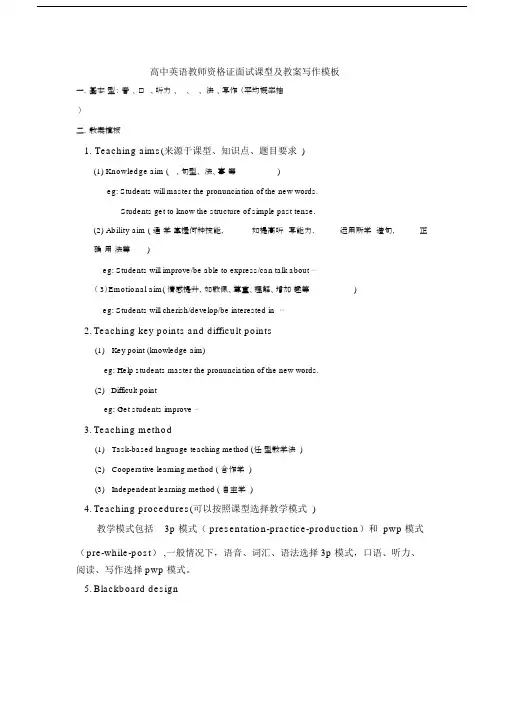
高中英语教师资格证面试课型及教案写作模板一.基本型:音、口、听力、、、法、写作(平均概率抽)二.教案模板1. Teaching aims(来源于课型、知识点、题目要求)(1) Knowledge aim ( 、句型、法、事等)eg: Students will master the pronunciation of the new words.Students get to know the structure of simple past tense.(2) Ability aim ( 通学掌握何种技能,如提高听写能力,运用所学造句,正确用法等)eg: Students will improve/be able to express/can talk about ⋯( 3)Emotional aim( 情感提升,如敬佩、尊重、理解、增加趣等)eg: Students will cherish/develop/be interested in⋯2.Teaching key points and difficult points(1)Key point (knowledge aim)eg: Help students master the pronunciation of the new words.(2) Difficult pointeg: Get students improve ⋯3.Teaching method(1)Task-based language teaching method (任型教学法 )(2)Cooperative learning method ( 合作学 )(3)Independent learning method ( 自主学 )4.Teaching procedures(可以按照课型选择教学模式 )教学模式包括3p 模式( presentation-practice-production)和 pwp 模式(pre-while-post) ,一般情况下,语音、词汇、语法选择 3p 模式,口语、听力、阅读、写作选择 pwp 模式。
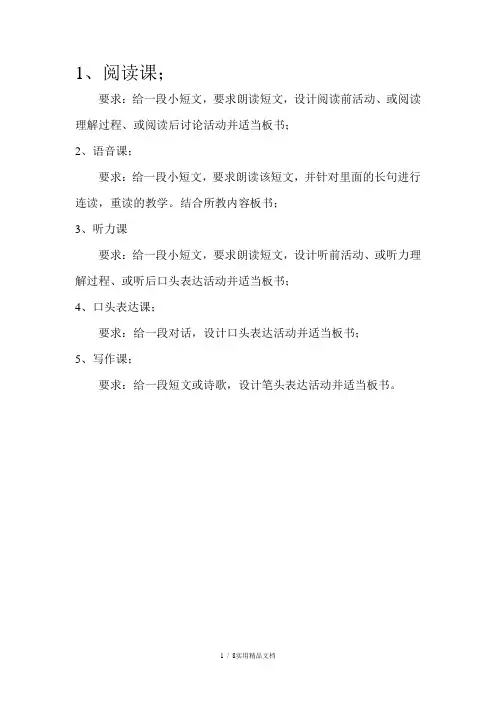
1、阅读课;要求:给一段小短文,要求朗读短文,设计阅读前活动、或阅读理解过程、或阅读后讨论活动并适当板书;2、语音课;要求:给一段小短文,要求朗读该短文,并针对里面的长句进行连读,重读的教学。
结合所教内容板书;3、听力课要求:给一段小短文,要求朗读短文,设计听前活动、或听力理解过程、或听后口头表达活动并适当板书;4、口头表达课;要求:给一段对话,设计口头表达活动并适当板书;5、写作课;要求:给一段短文或诗歌,设计笔头表达活动并适当板书。
教案模板一、写作Teaching Aims(教学目标):(1)Knowledge ~ (2) Ability~ (3) Emotional~Teaching Key and Difficult Points:…Teaching Procedures(教学过程):·Step1 Warming up and lead-in(time)·Step2 Pre-writing(time)·Step3 While-writing(time)(1) Drafting起草(2)editing校订修改·Step4 Post-writing(选两个样例到屏幕进行讲解) (time)·Step5 Summary and homework(time)Teaching reflection二、听说Teaching Aims(教学目标):(1) Knowledge ~ Students can learn some new words and expressions….(2) Ability~ Students can improve their listening and speaking skills.(3)Emotional~Teaching Key and Difficult Points:How to make students improve their listening and speaking skills. Teaching Procedures(教学过程):Step1 Pre-listening(time) Ask students some questions.Step2 While-listening(time)(1) Listen to the tape and fill in the blank.(2) Listen again and finish some questions.Step3 Post-listening(time)(1) Show the tape scripts on the PPT.(2) Group discussion: Talk about your friends.Step5 Summary and homework(time)Teaching reflection三、读写Teaching Aims(教学目标):(1)Knowledge ~Students can understand the main ideal and master the skills to describe…(2)Ability~Students can write their own ideals about…and their ability of reading a passage will be well developed.(2)Emotional~Students can share their experience with others.Teaching Key and Difficult Points:Students can write down their own methods of…in detail. Teaching Procedures(教学过程):Step1 Warming up and lead-in(time) Greeting.Talk sth about the passage.Step2 Reading and listening(time)Read and answer some questions. Then listen to the tape to check the answers.Step3 Pre-writing(time)Ask students to: think—select the useful information—write downStep4 While-writing(time)Ask students to write down the outline—provide some expressions—give time students to write the passage on paper.Step5 Post-writing(选两个样例到屏幕进行讲解) (time)Step6 Summary and homework(time)Summary: Ask students to retell what they’ve learnt in thisclass.Homework: Ask students to write a composition about…. Teaching reflection四、听力Teaching Aims(教学目标):(1) Knowledge ~Students can recognize the new words”…”and understand the meaning of the sentence patterns(句型)”…”.(2) Ability~Students will improve the skills of listening.(3)Emotional~Teaching Key and Difficult Points:Students can use the new words and sentence patterns to ask about…Teaching Procedures(教学过程):Step1 Pre-listening(time)Use PPT to teach new words and explain them.Step2 While-listening(time)Firstly: Play the tape, then ask 2 students to summarize the main ideal of the conversation.Secondly: Listen again and fill in the blank.Thirdly: Listen and ask students to repeat each sentence in turn.Step3 Post-listening(time)Role play: The teacher ask students to do a role play in groups. They should act out the dialogue clearly and correctly.Step4 Summary and homework(time)Finish the listening practice on text book after class. Teaching reflection五、阅读Teaching Aims(教学目标):(1) Knowledge ~Students can learn some important new words and expressions ,Students can understand the passage in detail.(2) Ability~Students can use some important new words and expressions correctly.Students can find out the main ideal and the specific information of this passage quickly.(3)Emotional~Teaching Key and Difficult Points:Students learn to use reading skills such as skimming and scanning. Teaching Procedures(教学过程):Step1 Pre-reading(time)Show some pictures and teach some new words.Step2 While-reading(time)(1) Fast reading and find out the main ideal.(2) Scanning for specific information.(3) Careful reading and judge the following sentences true or false:…Step3 Post-reading(time)Ask students to talk about…in groups and choose some to share with the class.Step4 Summary and homework(time)Share a passage you read after class next time.Teaching reflection六、语法Teaching Aims(教学目标):(1) Knowledge ~Students will master the sentence structure(例句中句子结构).(2) Ability~Students can apply the sentence structure to improve speaking ability for communication.(3) Emotional~Students will improve their awareness of communication through group work.Teaching Key and Difficult Points:The usage of…and how to use the sentence structure in daily life.Teaching Procedures(教学过程):Step1 Presentation(time)(1) Show an example and ask students to make sentences and write on the blackboard.(2) Ask students try to transfer it.(3) According to the sentences, invite students to summarize the structure of…(4) Explain the rules to students.Step2 Practice(time)(1) Ask students to work in pairs using the grammar to make dialogues.(2) 让同学研究相关语法变型。
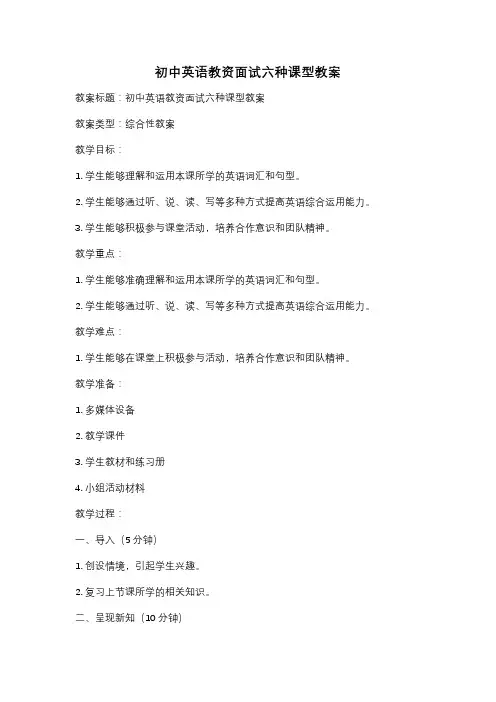
初中英语教资面试六种课型教案教案标题:初中英语教资面试六种课型教案教案类型:综合性教案教学目标:1. 学生能够理解和运用本课所学的英语词汇和句型。
2. 学生能够通过听、说、读、写等多种方式提高英语综合运用能力。
3. 学生能够积极参与课堂活动,培养合作意识和团队精神。
教学重点:1. 学生能够准确理解和运用本课所学的英语词汇和句型。
2. 学生能够通过听、说、读、写等多种方式提高英语综合运用能力。
教学难点:1. 学生能够在课堂上积极参与活动,培养合作意识和团队精神。
教学准备:1. 多媒体设备2. 教学课件3. 学生教材和练习册4. 小组活动材料教学过程:一、导入(5分钟)1. 创设情境,引起学生兴趣。
2. 复习上节课所学的相关知识。
二、呈现新知(10分钟)1. 通过多媒体设备呈现本课的主题和目标。
2. 介绍新的词汇和句型,并进行示范和操练。
三、合作探究(15分钟)1. 将学生分成小组,进行小组活动。
2. 每个小组选择一种课型,根据课本内容设计一个小故事或情景对话,并进行表演。
3. 教师引导学生进行角色扮演,并提供必要的语言支持。
四、展示与讨论(10分钟)1. 每个小组轮流展示他们设计的小故事或情景对话。
2. 教师和其他小组的学生进行评价和讨论,提出改进意见和建议。
五、巩固与拓展(15分钟)1. 教师设计相关练习,让学生巩固和拓展所学的知识。
2. 学生进行个人或小组练习,并进行互相检查和评价。
六、总结与反思(5分钟)1. 教师总结本节课的重点和难点。
2. 学生进行自我评价,反思学习过程中的不足和进步。
七、作业布置(5分钟)1. 布置相关的课后作业,巩固所学的知识。
2. 提醒学生及时完成作业,并做好复习准备。
教学延伸:1. 学生可以在课后自行设计其他类型的教案,并进行展示和讨论。
2. 学生可以参加英语角或英语俱乐部的活动,提高英语口语表达能力。
教学评价:1. 教师根据学生的课堂表现、小组活动和练习情况进行评价。
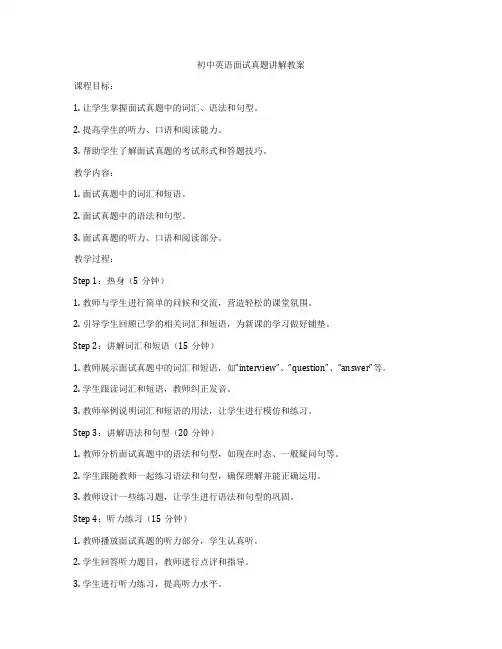
初中英语面试真题讲解教案课程目标:1. 让学生掌握面试真题中的词汇、语法和句型。
2. 提高学生的听力、口语和阅读能力。
3. 帮助学生了解面试真题的考试形式和答题技巧。
教学内容:1. 面试真题中的词汇和短语。
2. 面试真题中的语法和句型。
3. 面试真题的听力、口语和阅读部分。
教学过程:Step 1:热身(5分钟)1. 教师与学生进行简单的问候和交流,营造轻松的课堂氛围。
2. 引导学生回顾已学的相关词汇和短语,为新课的学习做好铺垫。
Step 2:讲解词汇和短语(15分钟)1. 教师展示面试真题中的词汇和短语,如“interview”、“question”、“answer”等。
2. 学生跟读词汇和短语,教师纠正发音。
3. 教师举例说明词汇和短语的用法,让学生进行模仿和练习。
Step 3:讲解语法和句型(20分钟)1. 教师分析面试真题中的语法和句型,如现在时态、一般疑问句等。
2. 学生跟随教师一起练习语法和句型,确保理解并能正确运用。
3. 教师设计一些练习题,让学生进行语法和句型的巩固。
Step 4:听力练习(15分钟)1. 教师播放面试真题的听力部分,学生认真听。
2. 学生回答听力题目,教师进行点评和指导。
3. 学生进行听力练习,提高听力水平。
Step 5:口语练习(10分钟)1. 教师设计一些口语任务,如角色扮演、模拟面试等。
2. 学生分组进行口语练习,教师巡回指导。
3. 学生展示口语练习成果,教师进行评价和鼓励。
Step 6:阅读练习(10分钟)1. 教师分发面试真题的阅读部分,学生独立阅读。
2. 学生回答阅读题目,教师进行点评和指导。
3. 学生进行阅读练习,提高阅读能力。
Step 7:总结和作业布置(5分钟)1. 教师对本节课的内容进行总结,强调重点和难点。
2. 布置作业,让学生巩固所学知识。
教学评估:1. 课堂参与度:观察学生在课堂上的积极参与程度,包括发言、练习等。
2. 发音准确性:关注学生在发音方面的准确性,及时纠正错误。

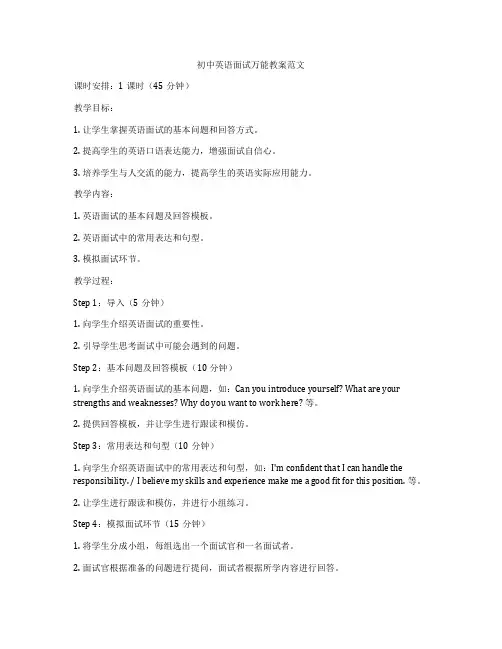
初中英语面试万能教案范文课时安排:1课时(45分钟)教学目标:1. 让学生掌握英语面试的基本问题和回答方式。
2. 提高学生的英语口语表达能力,增强面试自信心。
3. 培养学生与人交流的能力,提高学生的英语实际应用能力。
教学内容:1. 英语面试的基本问题及回答模板。
2. 英语面试中的常用表达和句型。
3. 模拟面试环节。
教学过程:Step 1:导入(5分钟)1. 向学生介绍英语面试的重要性。
2. 引导学生思考面试中可能会遇到的问题。
Step 2:基本问题及回答模板(10分钟)1. 向学生介绍英语面试的基本问题,如:Can you introduce yourself? What are your strengths and weaknesses? Why do you want to work here? 等。
2. 提供回答模板,并让学生进行跟读和模仿。
Step 3:常用表达和句型(10分钟)1. 向学生介绍英语面试中的常用表达和句型,如:I'm confident that I can handle the responsibility. / I believe my skills and experience make me a good fit for this position. 等。
2. 让学生进行跟读和模仿,并进行小组练习。
Step 4:模拟面试环节(15分钟)1. 将学生分成小组,每组选出一个面试官和一名面试者。
2. 面试官根据准备的问题进行提问,面试者根据所学内容进行回答。
3. 鼓励其他学生观摩并给予反馈。
Step 5:总结与反思(5分钟)1. 让学生总结自己在面试中的表现和收获。
2. 教师给予鼓励和建议,并提出改进措施。
教学评价:1. 观察学生在模拟面试中的表现,评估其口语表达能力和面试技巧。
2. 收集学生反馈,了解他们对英语面试的认识和感受。
3. 结合学生的课堂表现和模拟面试结果,给予综合评价。
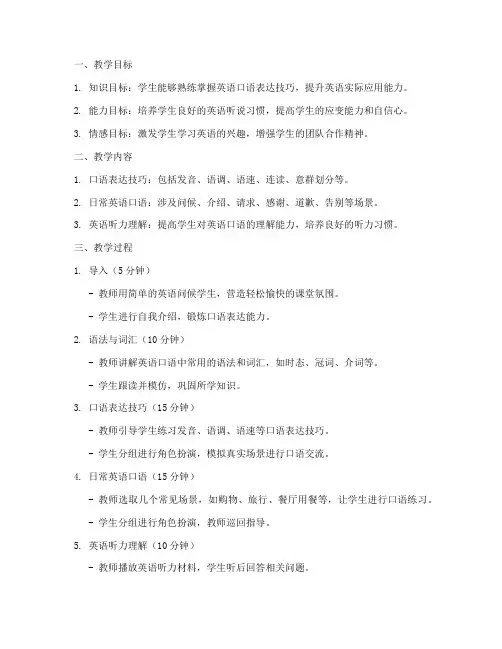
一、教学目标1. 知识目标:学生能够熟练掌握英语口语表达技巧,提升英语实际应用能力。
2. 能力目标:培养学生良好的英语听说习惯,提高学生的应变能力和自信心。
3. 情感目标:激发学生学习英语的兴趣,增强学生的团队合作精神。
二、教学内容1. 口语表达技巧:包括发音、语调、语速、连读、意群划分等。
2. 日常英语口语:涉及问候、介绍、请求、感谢、道歉、告别等场景。
3. 英语听力理解:提高学生对英语口语的理解能力,培养良好的听力习惯。
三、教学过程1. 导入(5分钟)- 教师用简单的英语问候学生,营造轻松愉快的课堂氛围。
- 学生进行自我介绍,锻炼口语表达能力。
2. 语法与词汇(10分钟)- 教师讲解英语口语中常用的语法和词汇,如时态、冠词、介词等。
- 学生跟读并模仿,巩固所学知识。
3. 口语表达技巧(15分钟)- 教师引导学生练习发音、语调、语速等口语表达技巧。
- 学生分组进行角色扮演,模拟真实场景进行口语交流。
4. 日常英语口语(15分钟)- 教师选取几个常见场景,如购物、旅行、餐厅用餐等,让学生进行口语练习。
- 学生分组进行角色扮演,教师巡回指导。
5. 英语听力理解(10分钟)- 教师播放英语听力材料,学生听后回答相关问题。
- 教师总结听力技巧,提高学生的听力水平。
6. 总结与反馈(5分钟)- 教师对学生的表现进行总结,指出优点和不足。
- 学生进行自我评价,分享学习心得。
四、教学评价1. 学生在课堂上的口语表达流畅程度。
2. 学生对英语口语表达技巧的掌握程度。
3. 学生在角色扮演中的表现。
4. 学生对英语听力材料的理解程度。
五、教学反思1. 教师根据学生的表现,调整教学策略,提高教学质量。
2. 教师关注学生的学习需求,激发学生的学习兴趣。
3. 教师鼓励学生积极参与课堂活动,培养学生的自信心。
备注:本教案设计适用于英语面试考场,旨在帮助学生提升英语口语表达能力和听力理解能力。
在教学过程中,教师应根据学生的实际情况灵活调整教学内容和教学方法。
教学目标:1. 熟悉小学英语面试试卷的结构和题型。
2. 培养应试者的阅读理解、听力理解、写作和口语表达能力。
3. 增强应试者的应试技巧和信心。
教学重点:1. 阅读理解题目的解题技巧。
2. 听力理解题目的解题技巧。
3. 写作和口语表达能力的提升。
教学难点:1. 如何在有限的时间内快速准确地完成题目。
2. 如何在口语表达中展现自己的英语水平。
教学过程:一、导入1. 介绍小学英语面试试卷的结构和题型,让学生对考试形式有初步了解。
2. 提出本次课程的教学目标,让学生明确学习重点。
二、阅读理解1. 分析阅读理解题目的特点,讲解解题技巧。
2. 提供阅读理解练习题,让学生进行实战演练。
3. 对学生的答案进行点评,指出优点和不足。
三、听力理解1. 分析听力理解题目的特点,讲解解题技巧。
2. 提供听力理解练习题,让学生进行实战演练。
3. 对学生的答案进行点评,指出优点和不足。
四、写作1. 分析写作题目的要求,讲解写作技巧。
2. 提供写作练习题,让学生进行实战演练。
3. 对学生的作文进行点评,指出优点和不足。
五、口语表达1. 分析口语表达题目的要求,讲解口语表达技巧。
2. 提供口语表达练习题,让学生进行实战演练。
3. 对学生的口语表达进行点评,指出优点和不足。
六、总结与反馈1. 总结本次课程的教学内容,让学生回顾所学知识。
2. 针对学生在课堂上的表现,给予鼓励和指导。
3. 布置课后作业,让学生巩固所学知识。
教学评价:1. 课堂参与度:观察学生在课堂上的表现,如回答问题、参与讨论等。
2. 作业完成情况:检查学生的课后作业,了解学生对知识的掌握程度。
3. 课堂测试:通过课堂测试,检验学生对教学内容的掌握情况。
教学反思:1. 根据学生的学习情况,调整教学内容和方法。
2. 关注学生的学习需求,提供针对性的辅导。
3. 提高自身的教学水平,为学生提供更优质的教学服务。
一、教学目标1. 培养学生的英语口语表达能力,提高学生的英语交际能力。
2. 培养学生的英语听力理解能力,提高学生的英语听力水平。
3. 培养学生的英语阅读理解能力,提高学生的英语阅读速度和准确性。
4. 培养学生的英语写作能力,提高学生的英语写作水平。
二、教学内容1. 口语表达:自我介绍、询问问题、回答问题等。
2. 听力理解:听懂日常生活中的简单对话和故事。
3. 阅读理解:阅读简单的英语短文,理解文章大意。
4. 写作:写简单的英语句子和短文。
三、教学过程1. 导入新课(1)教师用英语进行简单的自我介绍,激发学生的兴趣。
(2)播放一段英语歌曲或动画,让学生感受英语氛围。
2. 口语表达(1)教师引导学生进行自我介绍,如姓名、年龄、爱好等。
(2)教师提问学生问题,如:“What’s your name?”、“How old are you?”等,让学生回答。
(3)教师组织学生进行小组讨论,让学生用英语表达自己的观点。
3. 听力理解(1)播放一段简单的英语对话或故事,让学生听并回答问题。
(2)教师总结听力内容,讲解重点词汇和短语。
4. 阅读理解(1)分发一篇简单的英语短文,让学生阅读并回答问题。
(2)教师讲解文章大意,总结文章内容。
5. 写作(1)教师引导学生用英语写简单的句子,如描述自己的家庭、朋友等。
(2)教师组织学生进行小组合作,共同完成一篇短文。
6. 课堂小结(1)教师总结本节课所学内容,强调重点。
(2)鼓励学生课后继续学习,提高英语水平。
四、教学评价1. 课堂参与度:观察学生在课堂上的发言、提问和回答问题的情况。
2. 口语表达能力:评价学生在口语表达方面的流畅度和准确性。
3. 听力理解能力:评价学生在听力理解方面的准确性和速度。
4. 阅读理解能力:评价学生在阅读理解方面的速度和准确性。
5. 写作能力:评价学生在写作方面的句子结构和内容。
五、教学反思1. 教师应关注学生的个体差异,因材施教。
2. 教师应创设生动有趣的课堂氛围,激发学生的学习兴趣。
1、阅读课;要求:给一段小短文,要求朗读短文,设计阅读前活动、或阅读理解过程、或阅读后讨论活动并适当板书;2、语音课;要求:给一段小短文,要求朗读该短文,并针对里面的长句进行连读,重读的Teaching Key and Difficult Points:…Teaching Procedures(教学过程):·Step1 Warming up and lead-in(time)·Step2 Pre-writing(time)·Step3 While-writing(time)(1) Drafting起草(2)editing校订修改·Step4 Post-writing(选两个样例到屏幕进行讲解) (time)·Step5 Summary and homework(time)Teaching reflection….(1) Show the tape scripts on the PPT.(2) Group discussion: Talk about your friends.Step5 Summary and homework(time)Teaching reflection三、读写Teaching Aims(教学目标):(1)Knowledge ~Students can understand the main ideal and master the skills to describe…(2)Ability~Students can write their own ideals about…and their ability of reading a passageAsk students to write down the outline—provide some expressions—give time students to write the passage on paper.Step5 Post-writing(选两个样例到屏幕进行讲解) (time)Step6 Summary and homework(time)Summary: Ask students to retell what they’ve learnt in this class.Homework: Ask students to write a composition about….Teaching reflection四、听力Teaching Aims(教学目标):(1) Knowledge ~Secondly: Listen again and fill in the blank.Thirdly: Listen and ask students to repeat each sentence in turn.Step3 Post-listening(time)Role play: The teacher ask students to do a role play in groups. They should act out the dialogue clearly and correctly.Step4 Summary and homework(time)Finish the listening practice on text book after class.Teaching reflection五、阅读Teaching Aims(教学目标):Step2 While-reading(time)(1) Fast reading and find out the main ideal.(2) Scanning for specific information.(3) Careful reading and judge the following sentences true or false:…Step3 Post-reading(time)Ask students to talk about…in groups and choose some to share with the class.Step4 Summary and homework(time)Share a passage you read after class next time.Teaching reflection六、语法blackboard.(2) Ask students try to transfer it.(3) According to the sentences, invite students to summarize the structure of…(4) Explain the rules to students.Step2 Practice(time)(1) Ask students to work in pairs using the grammar to make dialogues.(2) 让同学研究相关语法变型。
一、教学目标1. 知识目标:学生能够掌握小学英语面试常见题型及答题技巧,为面试做好准备。
2. 能力目标:提高学生的英语口语表达能力,培养良好的沟通技巧。
3. 情感目标:激发学生对英语学习的兴趣,增强自信心。
二、教学重点1. 熟悉小学英语面试题型。
2. 掌握各类题型的答题技巧。
3. 提高英语口语表达能力。
三、教学难点1. 针对不同题型,灵活运用答题技巧。
2. 在面试过程中,保持自信,流利表达。
四、教学过程1. 导入(1)教师简要介绍小学英语面试的背景和意义。
(2)提问学生:你们知道小学英语面试有哪些题型吗?2. 讲解各类题型及答题技巧(1)词汇题- 教师讲解词汇题的类型及答题技巧,如拼写、同义词、反义词等。
- 学生进行词汇练习,教师点评。
(2)语法题- 教师讲解语法题的类型及答题技巧,如时态、语态、非谓语动词等。
- 学生进行语法练习,教师点评。
(3)阅读理解题- 教师讲解阅读理解题的类型及答题技巧,如主旨大意、细节理解、推理判断等。
- 学生进行阅读练习,教师点评。
(4)听力题- 教师讲解听力题的类型及答题技巧,如关键词、主旨大意、事实细节等。
- 学生进行听力练习,教师点评。
(5)口语表达题- 教师讲解口语表达题的类型及答题技巧,如自我介绍、日常对话等。
- 学生进行口语练习,教师点评。
3. 综合练习(1)教师提供模拟面试场景,让学生进行实战演练。
(2)教师点评学生的表现,指出不足之处。
4. 总结与反馈(1)教师总结本节课所学内容,强调重点。
(2)学生分享自己的学习心得,提出疑问。
五、教学评价1. 学生对各类题型的掌握程度。
2. 学生在模拟面试中的表现。
3. 学生在课堂上的参与度。
六、教学反思1. 教师针对学生的掌握情况,调整教学内容和方法。
2. 教师关注学生的情感需求,激发学生的学习兴趣。
3. 教师在课后进行教学反思,总结经验教训。
通过以上教学过程,使学生熟悉小学英语面试题型,掌握各类题型的答题技巧,提高英语口语表达能力,为面试做好准备。
英语面试教案教案标题:英语面试教案教案目标:- 帮助学生准备英语面试所需的语言能力和技巧。
- 提供学生在面试过程中的自信和流利表达能力。
教学步骤:1. 热身活动:(5分钟)- 让学生进行简单的自我介绍。
为此,可以提前准备一些问题,如姓名、年龄、兴趣爱好等。
- 引导学生用简洁的语言简要介绍自己。
2. 面试技巧介绍:(10分钟)- 与学生一起讨论英语面试的一般要求和技巧,如保持良好的姿态、眼神交流、自信的表达等。
- 强调语言能力和流利度的重要性,并提醒学生注意语法和发音。
3. 面试问题练习:(20分钟)- 准备一些常见的面试问题,如“你能介绍一下自己吗?”、“你有什么特长或优势?”、“你为什么想学习英语?”等。
- 分成小组进行角色扮演,其中一人扮演面试官,另一人扮演求职者。
学生可以轮流扮演不同的角色,以便他们能够充分理解不同角色的需求和期望。
4. 反馈和改进:(10分钟)- 结合面试练习,给予学生积极的反馈和建议。
- 引导学生对自己的回答进行自我评价,看是否能用更准确和流利的表达方式来回答问题。
5. 模拟面试:(15分钟)- 在真实的面试场景中模拟面试过程。
学生扮演求职者,教师或其他同学扮演面试官。
- 面试官可以提问一些开放性问题,学生应根据自己的经验和知识做出回答。
6. 结束活动:(5分钟)- 进行总结,强调学生在面试中所学到的技巧和反馈。
- 鼓励学生继续努力,并提供额外的面试准备资源。
教学资源:- 提前准备一些常见面试问题。
- 过渡词汇和表达使用的提示卡片。
- 角色扮演活动所需的素材。
教案评估:- 观察学生在面试练习和模拟面试中的表现,并给予及时的反馈。
- 评估学生回答问题的流利度、语法和发音。
教案扩展:- 提供额外的面试练习和素材,帮助学生进一步提高自己的面试技巧。
- 组织学生参观面试或邀请有经验的面试官来进行面试模拟。
英语教资面试题型在英语教资考试中,面试是一个重要的环节。
面试题型多样,不同的题型考察不同的能力和技巧。
以下将按照常见的英语教资面试题型进行介绍。
一、自我介绍自我介绍是面试的第一个环节,考官通过自我介绍了解考生的基本情况和表达能力。
在自我介绍中,考生需注意以下几点:1.简洁明了,突出重点;2.用简单的句子表达个人信息;3.展示自己的特长和优势。
二、教育背景和教学经验考官通常会询问考生的教育背景和教学经验,以评估其教学能力和教育素养。
在回答这类问题时,考生需注意以下几点:1.清晰明了地介绍自己的教育背景和教学经验;2.突出自己在教学过程中取得的成绩和经验;3.用简练的语言描述,并陈述相关教学理念和方法。
三、教学设计教学设计是考察考生教学设计能力和应对教学实际问题的能力。
考生需要根据所给的教学任务或问题,进行合理的教学设计,包括教学目标、教学内容、教学方法等。
在进行教学设计时,需要注意以下几点:1.明确教学目标,确保与教学任务相符;2.合理设置教学内容和步骤,使教学过程有条不紊;3.选择合适的教学方法和教具,提高教学效果;4.注意引导学生的思考和参与,激发学生的学习兴趣。
四、教学案例分析教学案例分析是考察考生解决实际教学问题的能力。
考生需要针对给出的教学案例,进行分析和解决问题。
在进行教学案例分析时,需要注意以下几点:1.准确把握问题的本质和关键点,进行全面分析;2.提出解决问题的具体方法和策略,并给出实施步骤;3.合理评估所提出的解决方案的可行性和有效性。
五、交流互动交流互动是考察考生与学生交流沟通能力和语言交际能力的环节。
考生需要在与考官或其他考生进行交流时,遵循以下原则:1.表达清晰明了,语言准确用词;2.积极参与讨论,提出自己的观点和见解;3.注意倾听和尊重他人的观点。
以上是英语教资面试中常见的题型和注意事项。
通过充分准备和练习,考生可以在面试中展现出自己的优势和能力,取得良好的成绩。
祝各位考生成功!。
1、阅读课;要求:给一段小短文,要求朗读短文,设计阅读前活动、或阅读理解过程、或阅读后讨论活动并适当板书;2、语音课;要求:给一段小短文,要求朗读该短文,并针对里面的长句进行连读,重读的教学。
结合所教内容板书;3、听力课要求:给一段小短文,要求朗读短文,设计听前活动、或听力理解过程、或听后口头表达活动并适当板书;4、口头表达课;要求:给一段对话,设计口头表达活动并适当板书;5、写作课;要求:给一段短文或诗歌,设计笔头表达活动并适当板书。
—教案模板)一、写作Teaching Aims(教学目标):(1)Knowledge ~ (2) Ability~ (3) Emotional~Teaching Key and Difficult Points:…Teaching Procedures(教学过程):·Step1 Warming up and lead-in(time)·Step2 Pre-writing(time)·Step3 While-writing(time)(1) Drafting起草(2)editing校订修改!·Step4 Post-writing(选两个样例到屏幕进行讲解) (time)·Step5 Summary and homework(time)Teaching reflection二、听说Teaching Aims(教学目标):(1) Knowledge ~ Students can learn some new words and expressions….(2) Ability~ Students can improve their listening and speaking skills.Teaching Key and Difficult Points:/How to make students improve their listening and speaking skills. Teaching Procedures(教学过程):Step1 Pre-listening(time) Ask students some questions.Step2 While-listening(time)(1) Listen to the tape and fill in the blank.(2) Listen again and finish some questions.Step3 Post-listening(time)(1) Show the tape scripts on the PPT.(2) Group discussion: Talk about your friends.Step5 Summary and homework(time)Teaching reflection&三、读写Teaching Aims(教学目标):(1)Knowledge ~Students can understand the main ideal and master the skills to describe…(2)Ability~Students can write their own ideals about…and their ability of reading a passage will be well developed.Students can share their experience with others. Teaching Key and Difficult Points:》Students can write down their own methods of…in detail. Teaching Procedures(教学过程):Step1 Warming up and lead-in(time) Greeting.Talk sth about the passage.Step2 Reading and listening(time)Read and answer some questions. Then listen to the tape to check the answers.Step3 Pre-writing(time)Ask students to: think—select the useful information—write downStep4 While-writing(time)Ask students to write down the outline—provide some expressions—give time students to write the passage on paper.,Step5 Post-writing(选两个样例到屏幕进行讲解) (time)Step6 Summary and homework(time)Summary: Ask students to retell what they’ve learnt in thisclass.Homework: Ask students to write a composition about….Teaching reflection四、听力Teaching Aims(教学目标):(1) Knowledge ~Students can recognize the new words”…”and understand the meaning of the sentence patterns(句型)”…”.·(2) Ability~Students will improve the skills of listening.(3)Emotional~Teaching Key and Difficult Points:Students can use the new words and sentence patterns to ask about…Teaching Procedures(教学过程):Step1 Pre-listening(time)Use PPT to teach new words and explain them.Step2 While-listening(time)Firstly: Play the tape, then ask 2 students to summarize the main ideal of the conversation.¥Secondly: Listen again and fill in the blank.Thirdly: Listen and ask students to repeat each sentence inturn.Step3 Post-listening(time)Role play: The teacher ask students to do a role play in groups. They should act out the dialogue clearly and correctly.Step4 Summary and homework(time)Finish the listening practice on text book after class. Teaching reflection五、阅读Teaching Aims(教学目标):^(1) Knowledge ~Students can learn some important new words and expressions ,Students can understand the passage in detail.(2) Ability~Students can use some important new words and expressions correctly.Students can find out the main ideal and the specific information of this passage quickly.(3)Emotional~Teaching Key and Difficult Points:Students learn to use reading skills such as skimming and scanning. Teaching Procedures(教学过程):Step1 Pre-reading(time)Show some pictures and teach some new words.;Step2 While-reading(time)(1) Fast reading and find out the main ideal.(2) Scanning for specific information.(3) Careful reading and judge the following sentences true or false:…Step3 Post-reading(time)Ask students to talk about…in groups and choose some to share with the class.Step4 Summary and homework(time)Share a passage you read after class next time.Teaching reflection{六、语法Teaching Aims(教学目标):(1) Knowledge ~Students will master the sentence structure(例句中句子结构).(2) Ability~Students can apply the sentence structure to improve speaking ability for communication.(3) Emotional~Students will improve their awareness of communication through group work.Teaching Key and Difficult Points:The usage of…and how to use the sentence structure in daily life. (Teaching Procedures(教学过程):Step1 Presentation(time)(1) Show an example and ask students to make sentences and write on the blackboard.(2) Ask students try to transfer it.(3) According to the sentences, invite students to summarize the structure of…(4) Explain the rules to students.Step2 Practice(time)(1) Ask students to work in pairs using the grammar to make dialogues.(2) 让同学研究相关语法变型。